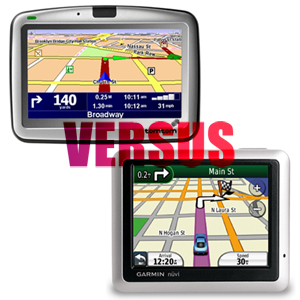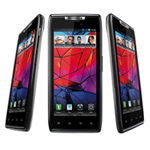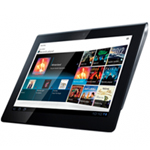Best GPS Devices
Top Rated GPS Devices 2024
Portable GPS navigators are useful tools to have in the car whether you’re traveling to unfamiliar cities or just navigating your own hometown. We reviewed several GPS devices and selected our top 10 based on the following factors:
1. Large, bright touchscreen display that’s visible even in sunlight
2. User-friendly interface with large icons
3. Good touchscreen responsiveness
4. Powers up and finds destinations quickly
5. Mounts easily to the windshield or dashboard and detaches for safekeeping
6. Provides free traffic updates and current maps
7. Gives adequate notice of upcoming turns
8. Speaks clearly and includes street names in the directions
9. Shows pertinent information on the screen like speed limit, ETA, and current location
10.Provides lane assistance in complicated junctions
|
2-hour battery life |
 This 5-inch GPS navigator from Garmin has a touchscreen that is very responsive and brighter than a lot of the competition. It’s also got a dual orientation feature…read more
This 5-inch GPS navigator from Garmin has a touchscreen that is very responsive and brighter than a lot of the competition. It’s also got a dual orientation feature…read more
|
2-hour battery life |
 Garmin is one of the most familiar names of portable GPS device makers. The 52LM model is available for a great low price with excellent performance…read more
Garmin is one of the most familiar names of portable GPS device makers. The 52LM model is available for a great low price with excellent performance…read more
|
Includes 1 nonstandard battery |
 The latest Garmin GPS navigator expands its touchscreen to 5 inches, which is very helpful when you’re driving and you need to glance at the GPS quickly…read more
The latest Garmin GPS navigator expands its touchscreen to 5 inches, which is very helpful when you’re driving and you need to glance at the GPS quickly…read more
|
Includes maps for U.S., Mexico, and Canada |
 The first portable GPS navigator to integrate travel apps into its functions, the TomTom GO Live allows you to connect to Yelp, TripAdvisor…
The first portable GPS navigator to integrate travel apps into its functions, the TomTom GO Live allows you to connect to Yelp, TripAdvisor…
read more
|
Includes lifetime maps for the U.S. |
 TomTom’s START 50M entry-level GPS device is perfect for those who only need one occasionally. These handy devices pay for themselves the first time you get yourself out of a pinch on the road…read more
TomTom’s START 50M entry-level GPS device is perfect for those who only need one occasionally. These handy devices pay for themselves the first time you get yourself out of a pinch on the road…read more
|
7-inch screen |
 We were impressed with the Magellan RoadMate 1700LM, which gives you audible cues to get off the highway, make a turn, or turn around. This feature comes in handy if you’re traveling through an unfamiliar…
We were impressed with the Magellan RoadMate 1700LM, which gives you audible cues to get off the highway, make a turn, or turn around. This feature comes in handy if you’re traveling through an unfamiliar…
read more
|
2-hour battery life |
 The TomTom GO 50 1FC5.019.01 is a handy tool to have when you’re traveling through unfamiliar regions. It’s nice having free traffic updates and a way to avoid tollroads without the annoying…
The TomTom GO 50 1FC5.019.01 is a handy tool to have when you’re traveling through unfamiliar regions. It’s nice having free traffic updates and a way to avoid tollroads without the annoying…
read more
|
4.3-inch screen |
 The Magellan RoadMate 2045T-LM has a 4.3-inch screen with 480 x 272 pixels. The GPS device picks up live traffic information without subscription and also shows you points of interest…
The Magellan RoadMate 2045T-LM has a 4.3-inch screen with 480 x 272 pixels. The GPS device picks up live traffic information without subscription and also shows you points of interest…
read more
GPS Device Buying Guide
A Portable GPS Navigator Buying Guide
As you shop for a GPS device to mount in your car, consider the following factors that can have an impact on your device’s effectiveness.
Screen size
There are GPS screens ranging from 2.5 to 7 inches. While the small screens can be difficult to see at a glance while you’re driving and cumbersome to type on, the large screens can block your view of the road when mounted on the windshield. Look for a GPS device with a screen around 4.5 to 5 inches as a good compromise. The 5-inch screens are especially easy to take in at a glance, especially if you’re driving a truck, RV, or other large vehicle.
Dynamic search
Typing on a touchpad screen can be cumbersome, especially if the screen isn’t very responsive. Some GPS devices include dynamic search options that predict the possible locations based on the letters you’ve typed in. If you see the correct destination, you can save yourself the trouble of typing it all in just by pressing it.
Lane assistance
As you approach complicated junctions, the lane assistance feature on your GPS navigator will help you figure out exactly which lane you need to be in to make your exit or turn.
Bluetooth
In a further effort to keep your hands on the wheel, many GPS navigators include Bluetooth connectivity, allowing you to make and receive calls through the loudspeaker without using your hands. You must have a phone that supports Bluetooth for this to work.
Mounting units
A GPS device can be attached either to the windshield or the dashboard with a suction cup mount. Look for mounts that hold the GPS navigator steady without vibrating. Also be aware that some states like Minnesota and California have restrictions on mounting any device to the windshield.
Charging options
Your GPS device can always be powered by the car adapter, but many also have an internal power supply that lasts a couple hours per charge. With an internal power supply, you can carry the GPS device along with you on bike rides or to navigate subway and bus stops. Often you can charge the GPS device through the USB cord plugged into the computer.
Street names
An ideal GPS navigator speaks the names of the streets you turn on so you don’t have to keep glancing at the screen for the directions. While this is a very helpful feature, be aware that some models are better at vocalizing text than others. When a GPS device can’t pronounce simple street names, it kind of defeats the purpose.
Traffic updates
Most high-end GPS devices offer real-time traffic updates, alerting you to accidents and traffic jams and rerouting you to a less congested path. Sometimes this traffic service is limited to major roads. Sometimes the traffic information comes through a subscription, and other times it’s free—but you’ll have to put up with pop-up ad banners.
Other special alerts and features
Advanced GPS navigators have advanced routing options, such as avoiding toll roads. Some GPS devices alert you to streets with speed cameras or intersections with red light cameras so you can advance with caution. The more versatile and flexible your GPS navigator, the more options you have on the road.
 |
Steve Holdgren is an engineer by trade and has worked for some of the largest energy related engineering firms in the world with his latest stint in Switzerland. He holds a degree is mechanical engineering… See more about Steve |
Featured GPS Articles
Comparing Garmin and TomTom: Two GPS Manufacturers

Garmin and TomTom dominate the GPS market, with many people split on which brand is better. Let’s take a look at the different interfaces and features each brand offers. The basic features of Garmin and TomTom GPS devices don’t … [more]
More Top 10 Lists
Top 10 Smartphones

A smartphone is an incredibly convenient gadget that helps organize your life and keep you entertained. We reviewed 10 smartphones and ranked them based on the following qualities: 1. Responsive touchscreen, 2. Well-designed user interface that’s easy to navigate … [more]
Top 10 Tablets

Top 10 tablets for 2012 … [more]
More GPS Devices
Filed Under: Electronics • GPS













